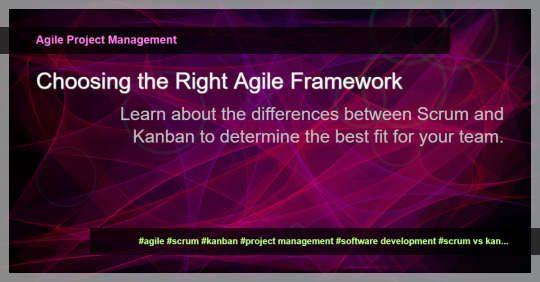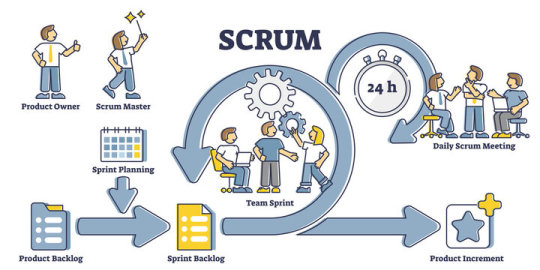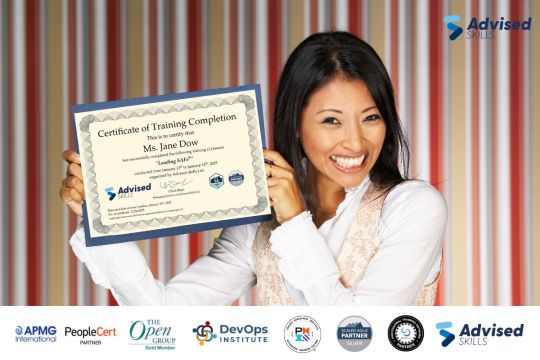#agile framework
Explore tagged Tumblr posts
Text
Why Adaptive Software Development is the Future of Agile
Discover why Adaptive Software Development (ASD) is redefining Agile with flexibility, collaboration, and continuous improvement for complex projects.
Agile methodologies have become the cornerstone of modern software development, offering a framework that prioritizes flexibility, rapid delivery, and close collaboration between developers and stakeholders. Among the agile frameworks, Adaptive Software Development (ASD) has emerged as a robust approach designed to handle the complexities of evolving projects, making it increasingly popular in…
#Adaptive Software Development#agile#Agile Framework#Agile Methodology#ASD#autism#Future Of Agile#mental-health#Project Management#Rapid Application Development#Software Development#Tech Innovation
0 notes
Text
Scrum Project Management: A Framework for Agile Success
Scrum project management has emerged as a leading methodology for Agile software development, providing teams with a flexible and iterative approach to delivering high-quality products. In this article, we'll delve into the fundamentals of Scrum, its key principles, roles, artifacts, events, benefits, challenges, implementation tips, and real-world applications.
I. Introduction
What is Scrum Project Management?
Scrum is a framework for Agile project management that emphasizes iterative development, collaboration, and continuous improvement. It enables teams to respond rapidly to changing requirements and deliver valuable software increments in short cycles.
Brief History and Evolution of Scrum
Originally introduced in the 1980s by Hirotaka Takeuchi and Ikujiro Nonaka, Scrum has since evolved into a widely adopted Agile methodology. Its principles draw inspiration from various fields, including lean manufacturing, empirical process control, and organizational psychology.
II. Core Principles of Scrum
Empirical Process Control
At the heart of Scrum lies the principle of empirical process control, which emphasizes transparency, inspection, and adaptation. Teams base their decisions on real-time feedback and data, rather than predefined plans.
Iterative Development
Scrum promotes iterative development, dividing work into small, manageable increments called "sprints." Each sprint typically lasts one to six weeks and results in a potentially shippable product increment.
Collaboration
Collaboration is central to Scrum, with cross-functional teams working closely together to achieve shared goals. Through frequent communication and collaboration, team members can address challenges and capitalize on opportunities more effectively.
Self-Organization
Scrum teams are self-organizing, meaning they have the autonomy to determine how best to accomplish their objectives. This autonomy fosters creativity, ownership, and accountability among team members.
III. Scrum Roles
Scrum Master
The Scrum Master serves as a servant-leader for the team, facilitating the Scrum process and removing impediments to progress. They coach the team on Agile principles and practices, ensuring adherence to Scrum values.
Product Owner
The Product Owner represents the stakeholders and is responsible for maximizing the value of the product. They prioritize the backlog, define user stories, and make decisions about what features to include in each sprint.
Development Team
The Development Team consists of professionals who do the work of delivering a potentially releasable increment of product at the end of each sprint. They are cross-functional and self-organizing, with a collective responsibility for achieving the sprint goal.
IV. Scrum Artifacts
Product Backlog
The Product Backlog is a prioritized list of all desired work on the project. It evolves over time, with new items added, refined, or removed based on feedback and changing requirements.
Sprint Backlog
The Sprint Backlog is a subset of the Product Backlog selected for implementation during a sprint. It represents the work that the Development Team plans to complete within the sprint.
Increment
The Increment is the sum of all the product backlog items completed during a sprint, plus the increments of all previous sprints. It must be in a potentially releasable state and meet the Definition of Done.
V. Scrum Events
Sprint Planning
Sprint Planning marks the beginning of a sprint, during which the Scrum Team collaborates to select the items from the Product Backlog that will be included in the upcoming sprint and create a sprint goal.
Daily Stand-up
The Daily Stand-up is a short, time-boxed meeting held every day to synchronize the activities of the Development Team and identify any impediments to progress. Each team member answers three questions: What did I do yesterday? What will I do today? Are there any impediments?
Sprint Review
The Sprint Review is held at the end of the sprint to inspect the increment and gather feedback from stakeholders. It provides an opportunity to review what was done in the sprint and adapt the Product Backlog as needed.
Sprint Retrospective
The Sprint Retrospective is a meeting held at the end of the sprint to reflect on the team's process and identify opportunities for improvement. It focuses on what went well, what could be improved, and actionable items for the next sprint.
VI. Benefits of Scrum
Improved Flexibility
Scrum's iterative approach allows teams to adapt to changing requirements and market conditions quickly. By delivering increments of working software regularly, teams can respond to feedback and deliver value more effectively.
Enhanced Product Quality
Through frequent inspection and adaptation, Scrum promotes a focus on quality throughout the development process. Continuous testing, peer reviews, and customer feedback help identify and address issues early, resulting in higher-quality products.
Increased Transparency
Scrum provides stakeholders with transparency into the development process, enabling them to track progress, provide feedback, and make informed decisions. This transparency builds trust and fosters collaboration between the development team and stakeholders.
Better Stakeholder Engagement
By involving stakeholders in the development process through events like the Sprint Review, Scrum ensures that their feedback is incorporated into the product. This engagement leads to greater satisfaction and alignment between the product and stakeholder expectations.
VII. Challenges in Implementing Scrum
Resistance to Change
Transitioning to Scrum requires a cultural shift within an organization, which can meet resistance from stakeholders accustomed to traditional project management methods. Overcoming resistance requires strong leadership, clear communication, and patience.
Lack of Experience
Inexperienced teams may struggle to implement Scrum effectively, leading to frustration and disillusionment. Training, mentoring, and hands-on experience can help teams build the skills and confidence needed to succeed with Scrum.
Overcommitment
Teams may overcommit to work during sprint planning, leading to burnout, reduced quality, and missed deadlines. It's essential to set realistic goals and prioritize the most valuable work to ensure sustainable pace and continuous delivery.
VIII. Tips for Successful Scrum Implementation
Training and Education
Invest in training and education for team members, Scrum Masters, and Product Owners to ensure a solid understanding of Scrum principles and practices.
Clear Communication
Foster open and transparent communication within the team and with stakeholders to ensure alignment and shared understanding of project goals and priorities.
Empowering Teams
Empower teams to self-organize and make decisions, trusting them to deliver results and continuously improve their process.
Continuous Improvement
Encourage a culture of continuous improvement, where teams reflect on their process, identify areas for enhancement, and experiment with new approaches.
IX. Scrum vs. Traditional Project Management
Scrum differs from traditional project management methodologies, such as Waterfall, in several key ways. While traditional methods emphasize detailed planning and documentation, Scrum prioritizes adaptability, collaboration, and delivering value early and often.
X. Real-world Applications of Scrum
Scrum is widely used across various industries and domains, from software development to marketing, healthcare, and beyond. Organizations like Spotify, Google, and Salesforce have adopted Scrum to streamline their processes and deliver innovative products to market faster.
XI. Conclusion
In conclusion, Scrum project management offers a powerful framework for Agile development, enabling teams to respond rapidly to change, deliver high-quality products, and maximize value for stakeholders. By embracing Scrum's core principles, roles, artifacts, and events, organizations can achieve greater flexibility, transparency, and collaboration, ultimately driving success in today's dynamic business environment.
XII. FAQs
What is the difference between Scrum and Agile?
While Agile is a broader philosophy or mindset, Scrum is a specific framework for implementing Agile principles in software development. Scrum provides guidelines and practices for iterative development, collaboration, and continuous improvement within Agile projects.
How does Scrum handle changes in requirements?
Scrum accommodates changes in requirements through its iterative approach and flexible mindset. Changes can be incorporated into the Product Backlog and prioritized for future sprints, allowing teams to adapt to evolving customer needs and market conditions.
Can Scrum be used in non-software projects?
Yes, Scrum can be applied to a wide range of projects beyond software development, including marketing campaigns, event planning, construction projects, and more. The key is to adapt Scrum principles and practices to suit the specific needs and constraints of the project.
What is the ideal size for a Scrum team?
The ideal size for a Scrum team is typically between five and nine members, although smaller or larger teams can also be effective depending on the project's complexity and requirements. The goal is to have a cross-functional team with the skills and expertise needed to deliver value independently.
How do you measure the success of a Scrum project?
Success in a Scrum project is measured by the value delivered to stakeholders, the quality of the product, and the team's ability to adapt and improve over time. Key metrics may include customer satisfaction, product quality, team velocity, and time-to-market.
#ScrumProjectManagement #AgileSuccess #ProjectManagement #AgileMethodology #ScrumFramework #AgileProjectManagement #SuccessTips #ProjectSuccess #AgileStrategies #ProjectManagementTips
#Scrum Project Management#Agile Success#Agile Methodology#Project Management#Scrum Framework#Agile Project Management#Project Success#Scrum Guide#Agile Techniques#Scrum Methodology#Agile Framework#Agile Project Success#Project Management Strategies#Scrum Mastery#Agile Mastery#Agile Project Management Techniques#Scrum Tips#Agile Project Management Guide#Agile Project Management Success#Scrum Project Management Tutorial#Project Management Tutorial#Agile Project Management Secrets#Scrum Project Management Blueprint#Agile Project Management Blueprint#Scrum Project Management Demystified#Agile Project Management Demystified#Agile Project Management Mastery
0 notes
Text
Scrum vs Kanban: Which Agile Framework is Right for You?
Scrum vs Kanban: Which Agile Framework is Right for You? Agile project management methodologies like Scrum and Kanban have gained significant popularity among software development teams. Both frameworks offer unique approaches to project planning, task management, and team collaboration. So, how do you decide which one is the best fit for your team? Scrum Scrum is an iterative and incremental…

View On WordPress
#agile#agile framework#Agile Project Management#kanban#project management#scrum#scrum vs kanban#software development#technologies
0 notes
Link
Best Tools for Agile Methodology: Enhancing Collaboration and Efficiency Agile methodology has become increasingly popular in software development due to its flexibility, iterative approach, and emphasis on collaboration. To effectively implement Agile practices, teams often rely on various tools and technologies that enhance communication, project management, and team collaboration. In this article, we will explore some of the best tools available for Agile teams, discussing their key features, benefits, and how they support the Agile principles.
#agile#agile framework#agile development#agile methodology#web developing company#web developers#web development#ecommerce
0 notes
Text
A Gentle Introduction To Scrum Methodology
If you’re new to project management, the term “scrum” might sound a little intimidating. However, it’s a term that’s become increasingly popular in the world of software development and project management in recent years. In this article we will go through a gentle introduction to Scrum methodology assuming you have never heard of it before. Scrum is a framework used for agile project…

View On WordPress
#Agile methodology#Daily Scrum meeting#Product Owner#Scrum framework#Scrum Master#Scrum team#Sprint planning
2 notes
·
View notes
Text
In today’s fast-paced digital world, organizations are constantly striving to adapt, innovate, and deliver value faster. Agile methodologies have become the backbone of successful businesses, helping teams collaborate efficiently, respond to change swiftly, and drive continuous improvement. But mastering Agile is not just about understanding the frameworks—it’s about acquiring the right mindset and skills. This is where Agile Training and Certification and Agile Coaching Services come into play. At Agile Sense, we help professionals and organizations unlock their full potential through expert training and coaching.
1 note
·
View note
Text
Is your career future-proof in the Agile era?
With organizations worldwide embracing large-scale Agile transformations, staying ahead means more than just keeping pace-it means leading the change.

Discover why the SAFe® Agilist certification is essential for unlocking new career opportunities, enhancing your leadership capabilities, and driving business agility in our latest blog post: Certified or Obsolete: How the Lack of a SAFe Agilist Certification Could Limit Your Career Growth
Ready to level up? Join our upcoming Leading SAFe® training and become a certified SAFe® Agilist. Gain practical tools, proven frameworks, and insights to lead Agile Release Trains, optimize value delivery, and drive results in your organization.
Don’t wait-spaces are filling up quickly! Register now https://www.advisedskills.com/agile-and-scrum/leading-safe
#BusinessAgility #SAFeAgilist #AgileLeadership #CareerGrowth #AdvisedSkills #SAFeTraining #ScaledAgileFramework #LeanAgile #AgileTransformation
#business agility#safe agilist#advisedskills#advised skills#scaled agile framework#lean-agile#agile leadership#agile transformation
1 note
·
View note
Text
How Project Management for Startups Differs from Enterprises

Explore the differences in project management for startups vs. enterprises. Learn how startups and enterprises prioritize and manage their workflow.
Read the full blog
#Project management for startups#Enterprise project management strategies#Agile project tools#Risk management frameworks
0 notes
Text
What is Scrum? A Comprehensive Introduction to Agile Project Management
Are you curious about Scrum? Discover how transparency, inspection, and adaptation drive Agile success. Learn the basics of board organization & the 5-3-3-5 structure! #ScrumProjectManagement #AgileLeadership #TeamCollaboration
Scrum has revolutionized project management across industries, offering a flexible and efficient approach to delivering value. But what exactly is Scrum, and how does it work? In this blog post, we’ll explore the theory behind Scrum—its foundation in transparency, inspection, and adaptation—before breaking down the essential components, such as board organization and the 5-3-3-5 structure. For…

View On WordPress
0 notes
Text
The beauty of LeSS: Scaling Agility
As organisations strive to enhance their agility and responsiveness, the challenge of scaling agile practices becomes increasingly significant. When teams grow in number and complexity, maintaining the core principles of agility—like collaboration, adaptability, and customer focus—can become difficult. This is where Large Scale Scrum (LeSS) comes into play, providing a framework designed to help…
#agile#Agile Frameworks#Agile Transformation#Continuous Improvement#LeSS#product management#Scaling Agility#Scrum#software development#Team collaboration
0 notes
Text
Elevate Your Business with Our Expert .NET Development Services!
🔹 Are you ready to transform your ideas into robust, scalable applications? Our team of skilled .NET developers is here to make it happen! 🔹
✅ Custom Solutions: Tailored applications that fit your unique business needs. ✅ Integrated Services: Smooth and secure integration with existing systems. ✅ Cross-Platform Support: Reach users anywhere with web, mobile, and desktop apps. ✅ Agile Methodology: We deliver results faster with iterative development.
🌟 Why Choose Us? ✨ Proven Expertise: Years of experience delivering cutting-edge .NET solutions. ✨ Collaboration Focused: Work closely with our team to bring your vision to life. ✨ Future-Proof Technology: Stay ahead of the curve with the latest advances.
📈 Let’s bring your project from ideas to reality! Contact us today for a FREE consultation! 💬
Email - [email protected] Skype:- skype:virtualcodersindia Website:- https://www.virtualcoders.net/

#dot net development services#tech innovation#Web Development#custom software development#agile development#Code With Us#software engineering#.net developers#.net framework
0 notes
Text
IMPLEMENTING ORGANIZATIONAL CHANGE MANAGEMENT STRATEGIES IN HEALTHCARE INSTITUTIONS
IMPLEMENTING ORGANIZATIONAL CHANGE MANAGEMENT STRATEGIES IN HEALTHCARE INSTITUTIONS 1.1 Introduction Organizational change is inevitable in healthcare institutions due to the dynamic nature of the industry, which is influenced by technological advancements, regulatory shifts, evolving patient needs, and economic pressures. Effective change management is critical to ensuring that healthcare…
#Agile methodologies#Change Impact Assessment#Change Leadership#Change management#Change Readiness#Communication Strategy#Continuous improvement#Cultural Change#Employee Buy-In#Healthcare transformation#Implementation Framework#IMPLEMENTING ORGANIZATIONAL CHANGE MANAGEMENT STRATEGIES IN HEALTHCARE INSTITUTIONS#organizational change#Patient-centered care#Performance metrics#PROCESS IMPROVEMENT#Project Management#Resistance to change#Stakeholder engagement#TECHNOLOGY ADOPTION#Training And Development
0 notes
Text
Beyond The Framework, A Conversation With Jeremy Berriault, SPaMCAST 830
SPaMCAST 830 features a conversation with Jeremy Berriault. Jeremy has a new book, “Beyond The Framework: Cultivating Agile Growthhttps://amzn.to/4evrM18.” The back cover states, “Organizations that fail to embrace agility (small a-agiity) risk fading into obscurity.” we discussed the basic assumptions of agile and why business agility differs from adopting any specific agile framework. Buy a…
0 notes
Text
Maximizing Career Growth with Scrum Master Courses and SAFe Agile Framework Certification
In today’s fast-paced business environment, mastering agile methodologies has become essential for professionals looking to enhance their career prospects. Scrum master courses and SAFe Agile Framework certification are two pivotal qualifications that can significantly elevate your professional standing in the industry. Whether you are a budding project manager, an experienced IT professional, or someone looking to transition into the agile workspace, obtaining these certifications can provide you with a competitive edge. Understanding Scrum Master Courses
Scrum master courses are designed to teach professionals the fundamentals of the Scrum framework, which is a popular agile methodology used for managing and completing complex projects. These courses cover essential topics such as sprint planning, team collaboration, and backlog management. By enrolling in a scrum master course, you not only learn the theoretical aspects of Scrum but also gain practical insights through real-world case studies and projects. Moreover, scrum master courses are ideal for professionals who want to step into leadership roles within agile teams. As a Scrum Master, your primary responsibility is to facilitate the Scrum process, ensuring that your team follows the principles of Scrum while also protecting them from external distractions. The skills you gain from these courses will help you lead your team to success by fostering a culture of continuous improvement and high performance.
The Importance of SAFe Agile Framework Certification
While scrum master courses focus on team-level Scrum practices, the SAFe Agile Framework certification extends your knowledge to the enterprise level. The Scaled Agile Framework (SAFe) is designed to help organizations apply agile methodologies across multiple teams, departments, and even entire organizations. This framework is particularly beneficial for large enterprises that require a coordinated approach to agile implementation.
Obtaining a SAFe Agile Framework certification demonstrates your ability to scale agile practices beyond individual teams and into broader organizational structures. This certification is highly valued in industries that require synchronization across various agile teams, making it an essential credential for senior agile practitioners, program managers, and portfolio managers. By understanding the intricacies of SAFe, you can play a pivotal role in driving large-scale agile transformations within your organization.
Advancing with Leading SAFe Certification
The Leading SAFe certification is a specialized qualification that focuses on leading agile transformations within an organization. This certification is tailored for leaders who are responsible for guiding their teams through the implementation of the SAFe framework. The Leading SAFe certification equips you with the skills needed to effectively lead and manage multiple agile teams, ensuring that they work in harmony towards achieving the organization’s strategic goals.
This certification is particularly useful for senior managers, executives, and change agents who are tasked with driving agile adoption at an enterprise level. With a Leading SAFe certification, you gain a deep understanding of how to align agile practices with business objectives, foster collaboration across departments, and create an agile culture that supports continuous improvement.
Conclusion
In conclusion, scrum master courses, SAFe Agile Framework certification, and Leading SAFe certification are critical qualifications for professionals aiming to thrive in the agile landscape. These certifications not only enhance your technical expertise but also position you as a leader capable of driving agile transformation in your organization. Whether you’re looking to manage a single team or lead an entire enterprise, investing in these certifications will undoubtedly propel your career to new heights.
0 notes
Link
Agile Methodology vs. Waterfall vs. Scrum: A Comprehensive Comparison
Software development methodologies play a crucial role in shaping the approach and success of software projects. Among the most widely used methodologies are Agile, Waterfall, and Scrum. Each methodology has its own strengths and weaknesses, and understanding the differences between them is essential for project managers and development teams. In this article, we will provide a comprehensive comparison of Agile, Waterfall, and Scrum methodologies, exploring their key principles, characteristics, and suitability for different project types.
#agile#agile framework#agile methodology#waterfall#waterfall methodology#scrum#web development#web developing company#web developers#ecommerce
0 notes
Text
Ever felt like customizing project tools turns into a Starship Enterprise mission? 🚀

Let's embrace the challenges, find the humor in our tasks, and continue to innovate and improve our workflows with Vabro.
After all for Vabro, every mission—no matter how small—contributes to the larger goal of delivering value and achieving success.
Visit Vabro to know more & try it for free.
#Vabro#Agile#Scrum#ProjectManagement#CustomerFocus#Framework#Methodology#Revolution#ProductOwner#ScrumMaster#Core
0 notes